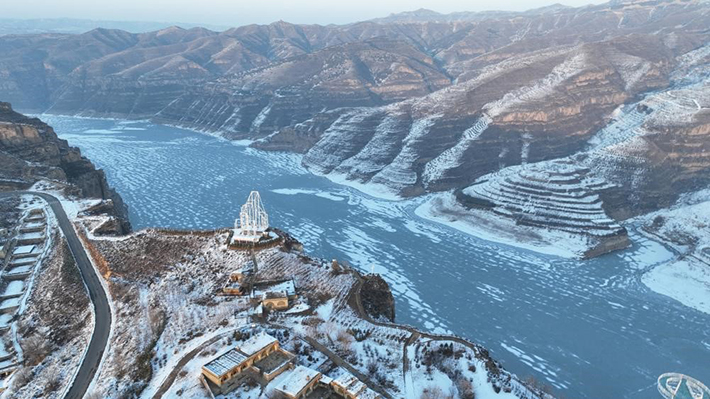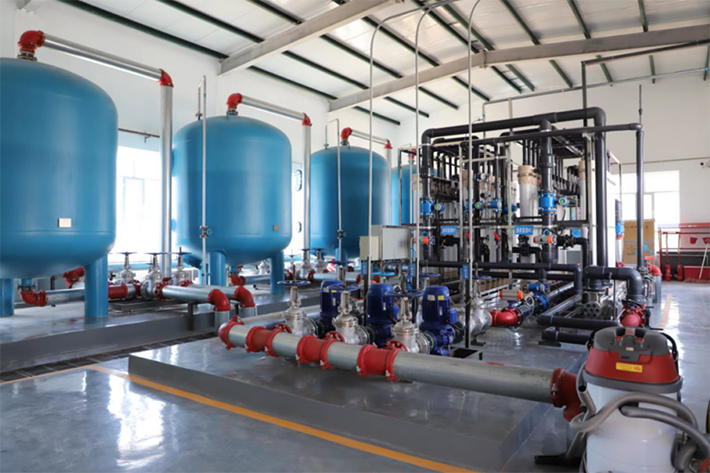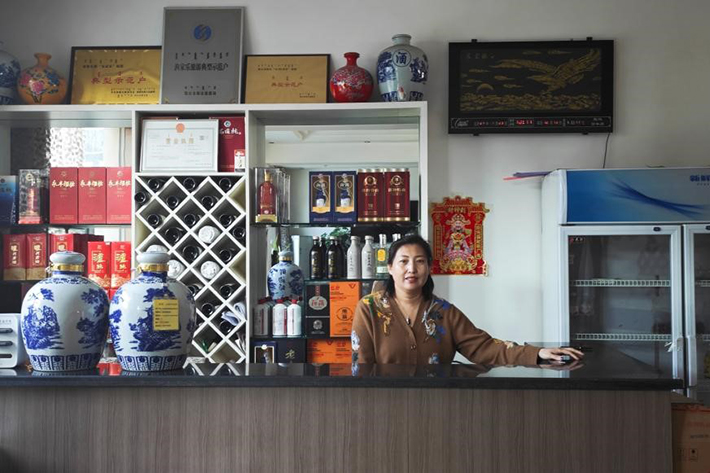
The breath-taking view of Jungar Yellow River Grand Canyon Scenic Area in winter (Courtesy)
Every winter, flocks of ruddy shelducks fly to Xiaotanzi, a village on the bank of the Yellow River in Jungar Banner in north China’s Inner Mongolia Autonomous Region. Here they blithely play over and on the waters, providing a lovely view to people.
The past few years have witnessed the issuance of numerous measures aimed at protecting the Yellow River’s Jungar Banner section that runs 238 km, notably for controlling desertification and industrial wastewater, as well as the introduction of the River Chief system. As a result of these measures, the water quality of the Yellow River has much improved and local residents enjoy a better living environment.
Making industrial wastewater reusable
Rich in minerals, Jungar Banner is a key industrial heartland in west Inner Mongolia. To tackle the pollution to the Yellow River by industrial wastewater released from factories, the local government has implemented a wastewater recycling initiative. “We are turning wastewater-induced ecological burdens and costs into dividends” said Zhang Kangping, director of the Water Environment Management Office at the Jungar Banner Branch of Erdos Municipal Bureau of Ecology and Environment.
As much as 300 tonnes of hypersaline wastewater is generated per hour by chemical enterprises in the Jungar Economic Development Zone, which is growing with the expansion of the economic development zone. High concentration of pollutants, great variety of soluble inorganic salt and complexity of components make it a challenging task to treat such a huge amount of hypersaline wastewater created by the chemical sector.
But a hypersaline wastewater treatment plant in Jungar Banner has been running on full blast where high-quality sodium chloride and sodium sulphate are extracted from the released hypersaline effluent.
Since 2020, a total of 143 million yuan ($19.9 million) has been invested by Jungar Banner State-Owned Gas Heating Co. for building the hypersaline wastewater treatment plant. In the plant installed with the latest waste treatment machines, tonnes of hypersaline wastewater are converted into useful products like sodium chloride and sodium sulphate through a proper recycling process.
Jungar Banner has also made great efforts in exploring ways to effectively reuse the wastewater. Mine drainage is surface water or groundwater that drains from a mine, and poses problems to the ecology. Zhang said that 18 million tonnes of mine drainage is generated annually by more than 130 coal mines in Jungar Banner, which has not only caused a waste of water resources, but also threatened the water quality in major rivers of the banner,” Zhang said.
Luckily, recycling mine drainage in Jungar Banner is relatively easy as it only contains a few types of suspended solids. In the Mine Drainage Purification Plant of the Guanzigou mine in Jungar Banner, the purified drainage water is kept in two underground reservoirs. “The reservoirs can hold 2,000 tonnes of water for both industrial and household use,” said Liu Zhili, director of the plant. According to him, the treated water only costs 3 yuan ($0.4) per tonne, which is less than half the previous price of 7 yuan ($0.97) per tonne of groundwater. Given this, the mine that consumes 2,500 tonnes of water a day could save nearly 10,000 yuan ($1,388.9) in daily water costs.

The mine drainage purification plant of Canzigou mine (Courtesy)
Combating soil erosion
As an arid and semi-arid area in the middle reaches of the Yellow River, Jungar Banner has been plagued with serious soil erosion. Sand control has been a major focus in the protection of the Yellow River.
Since 2000, Jungar Banner has invested 2.63 billion yuan ($365.4 million) in various ecosystem restoration projects. As a result, 6.41 million mu (427,333.33 hectares) of forest and grassland are planted, raising the forest coverage from 8.4 percent to 36.38 percent and the vegetation coverage from 16.6 percent to 76.2 percent. In addition, 61 km of embankments, over 800 soil-retaining dams and 2,000 debris dams have been built along the Yellow River, and a comprehensive project for water and soil conservation now incorporates 2.21 million mu (147,333.33 hectares) of land. With sand controlled and trees planted, the water in the river has become clearer.

Flocks of ruddy shelducks fly freely in Xiaotanzi Village (Yu Xiangjun)
To keep the Yellow River clean, 539 river chiefs in Jungar Banner has listed river inspection tours a routine task. As the river chief of the Yellow River in Xiaotanzi Village, Qiao Xu inspects the river twice a month to check what the situation is. In recent years, he notices an increasing number of migrant birds resting here. “More trees and grass are attracting more migrant birds. The environment is getting better,” he said. “And we feel a stronger sense of obligation of taking good care of our mother river.”
According to Xue Yong, director of the Nature Reserves and Wildlife Protection Management Office of the Jungar Banner Forestry and Grassland Bureau, towns on the bank of the Yellow River attract more than 200 kinds of birds, becoming an ideal habitat and place of rest for migrant birds, including white swans, ruddy ducks, grey cranes and other wildlife under the state's second level of protection.
Growing economic prosperity
Cleaner Yellow River has presented considerable opportunities for tourism development.
The 80-km Jungar Yellow River Grand Canyon Scenic Area in Dujiamao Village boasts the most prominent features of canyons in the Yellow River Basin. In the past, villagers lived off farming and made little money. Nowadays, tourism has become a major income source. With series of interactive tourism projects, the scenic area has received more than 300,000 tourists since 2021, which in turn creates buoyant demand for vacation rentals and restaurants and helps local per-capita income to grow by several times.
In the village of Xiaotanzi, there is always an endless stream of diners interested in local cuisine. Now the fishing village has become a famous destination for travellers who want to explore fishing tourism.

Yao Li, owner of a fishing-based agritainment business in Xiaotanzi Village (Xia Yuanyuan)
The booming tourism has also attracted villagers, who had moved to cities for work, back to the village to start their own businesses. In 2012, Yao Li closed her clothing store in the city and instead carried out fishing-based agritainment business in her hometown that now brings her an annual income of 200,000 ($27,777.8) to 300,000 yuan ($41,666.7). “We had to work in cities to make more money and yet now we can live a decent life in our hometown. The environment is more beautiful and we live more comfortably,” she said.
|
|